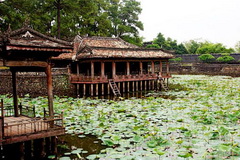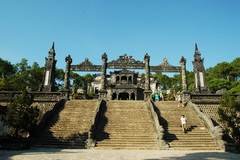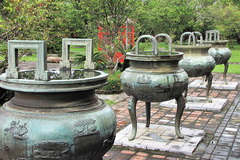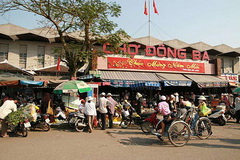



Le tombeau de Minh Mang est situé à l’extérieur de la ville, sur le mont Cam Ke, à 12 km de Hué, sur la rive ouest de la Rivière des Parfums.
.jpg)
En avril 1840, le roi Minh Mang changea le nom du mont "Cam Ke" en mont "Hieu Son" et donna au futur tombeau le nom de Hieu Lang. Sa construction commença en septembre.
En janvier 1841, le roi Minh Mang fut emporté par la maladie et son successeur, Thieu Tri, poursuivit cette œuvre.
En août, la dépouille du roi fut ensevelie à Buu Thanh, l’enceinte du tombeau, mais le tombeau ne fut totalement achevée qu’en 1843.

Travelling to Hue you may look for some corners where still keep remain it owns culture, architecture and a traditional food let visit Phuoc Tich ancient village with old house architectures, 500 years old temple and a collection of ceramic relics which are strong reflection of Hue culture....

L’école nationale de Huê se trouve sur la rue Lê Loi, quartier de Vinh Ninh, ville de Huê, province de Thua Thien-Hué.Quoc Tu Giam fut l’Ecole Nationale ouverte par la Cour pour former les élites intellectuelles de l’état. Au...

It is a delicate pavilion with a south view. In front of the Pavilion is a large court leading to the Nghinh Luong Pavilion (Pavilion for Fresh Air) on the Perfume River bank.There had once been a tiger - elephant duel on the pavilion grounds in 1829 to entertain Emperor Minh Mang. In his...

Le tombeau de Tu Duc est construit dans une vallée étroite appartenant au village de Duong Xuan Thuong (aujourd’hui, c’est le hameau de Thuong Ba, village de Thuy Xuan). Le tombeau est situé au milieu d’une immense forêt de pins, à 8 km du...

Huê ne serait pas la même sans la rivière Huong ou rivière des Parfums et le mont Ngu Binh, qui confèrent à l’ancienne cité des rois un cadre harmonieux et romantique. Une combinaison d’éléments indissociables que savent...

De tous les tombeaux impériaux qui jalonnent la rivière des Parfums, le mausolée de l’empereur Khai Dinh, l’avant-dernier souverain de la dynastie des Nguyên (1802-1945), est le plus étonnant, son architecture étant totalement différente...
.jpg)
Pagoda was built in the shape of the Chinese character "Khau" (mouth), with the main building consisting of three rooms and two wings. It faces the southeast and uses Ngu Binh Mount as a front screen.The pagoda was originally a small hut built by Nhat Dinh in 1843, who was formerly recognized by...
.jpg)
Établie comme capitale du Viet Nam unifié en 1802, la ville de Huê a été non seulement le centre politique mais aussi le centre culturel et religieux sous la dynastie Nguyên, jusqu'en 1945. La rivière des Parfums serpente à travers la...

The nine Dynastic Urns are the greatest bronze ones in Vietnam They were cast by Emperor Minh Mang in 1836 to symbolize the sovereignty of the dynasty.Each of them is named after the posthumous title of the emperors worshipped in the The Mieu Temple. For example, Cao Urn is named after Emperor...

Dong Ba Market is the biggest market in Thua Thien-Hue Province.Under the reign of King Gia Long (1802-1819), there was a big market named Qui Gia near Chanh Dong (Dong Ba) Gate of Hue Citadel. The name “Qui Gia” referred to the return to Phu Xuan Capital (Hue nowadays) of Nguyen...

Soyez le premier à connaître nos offres de voyage exclusives et les nouveaux circuits !.